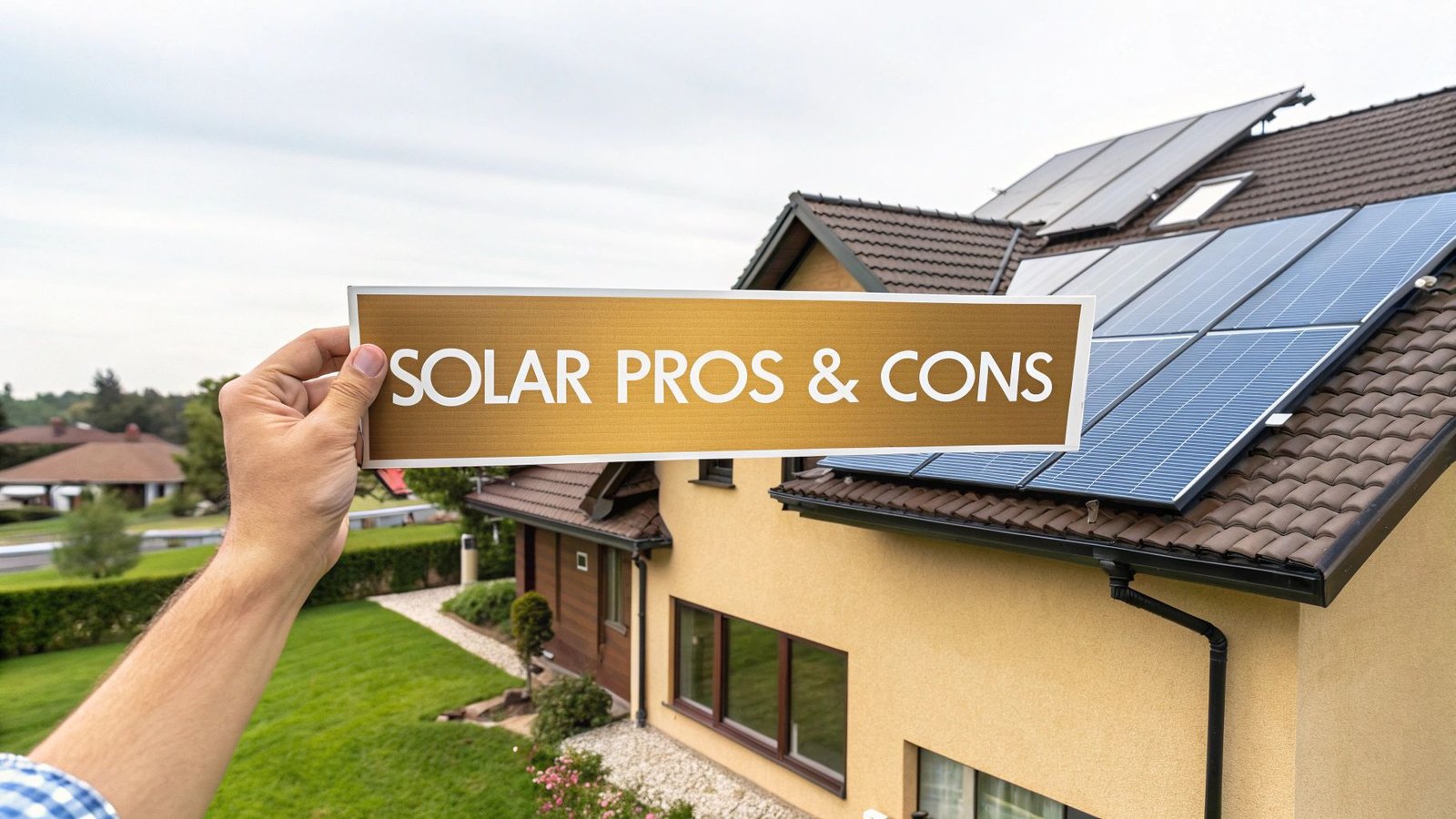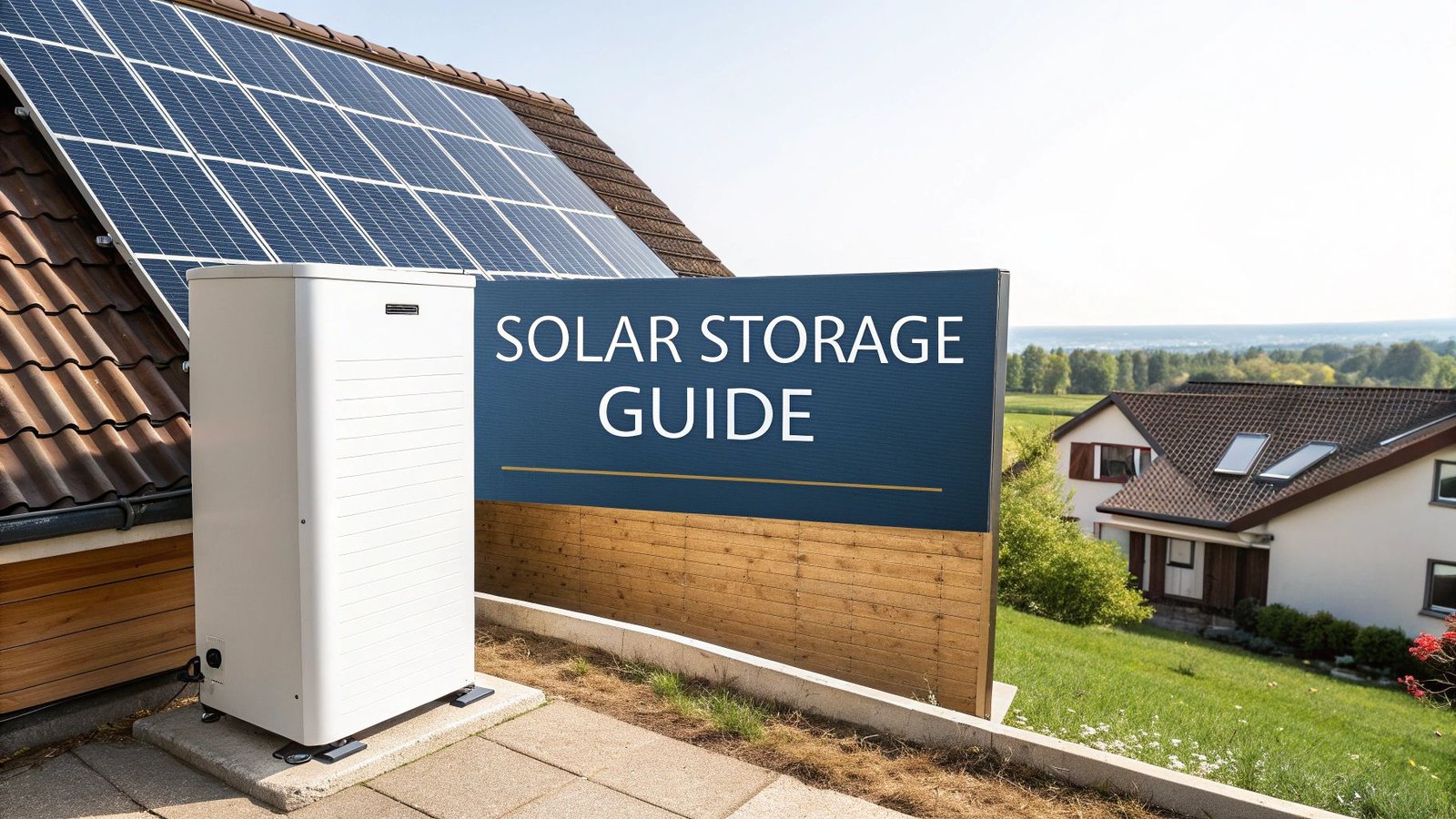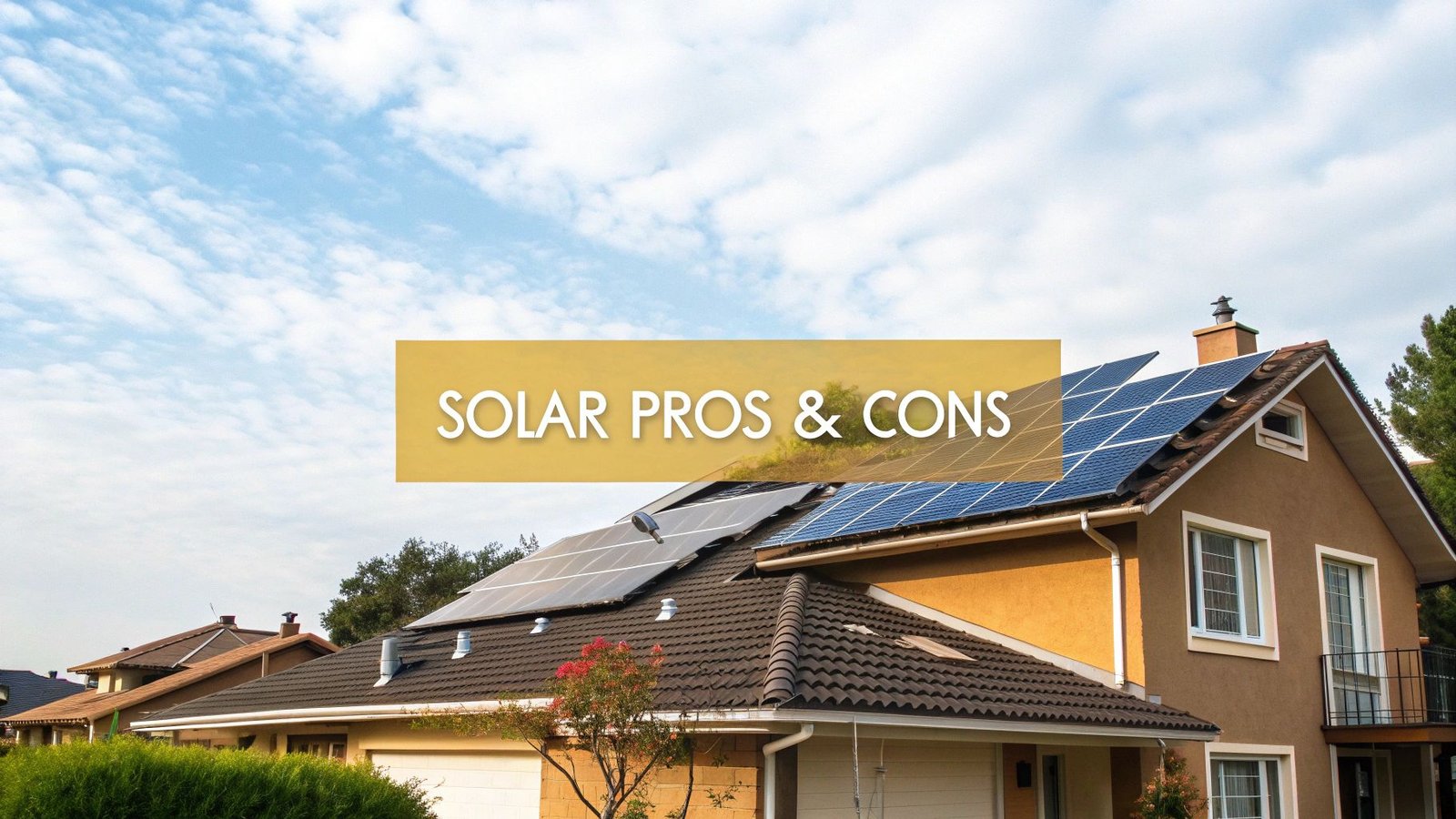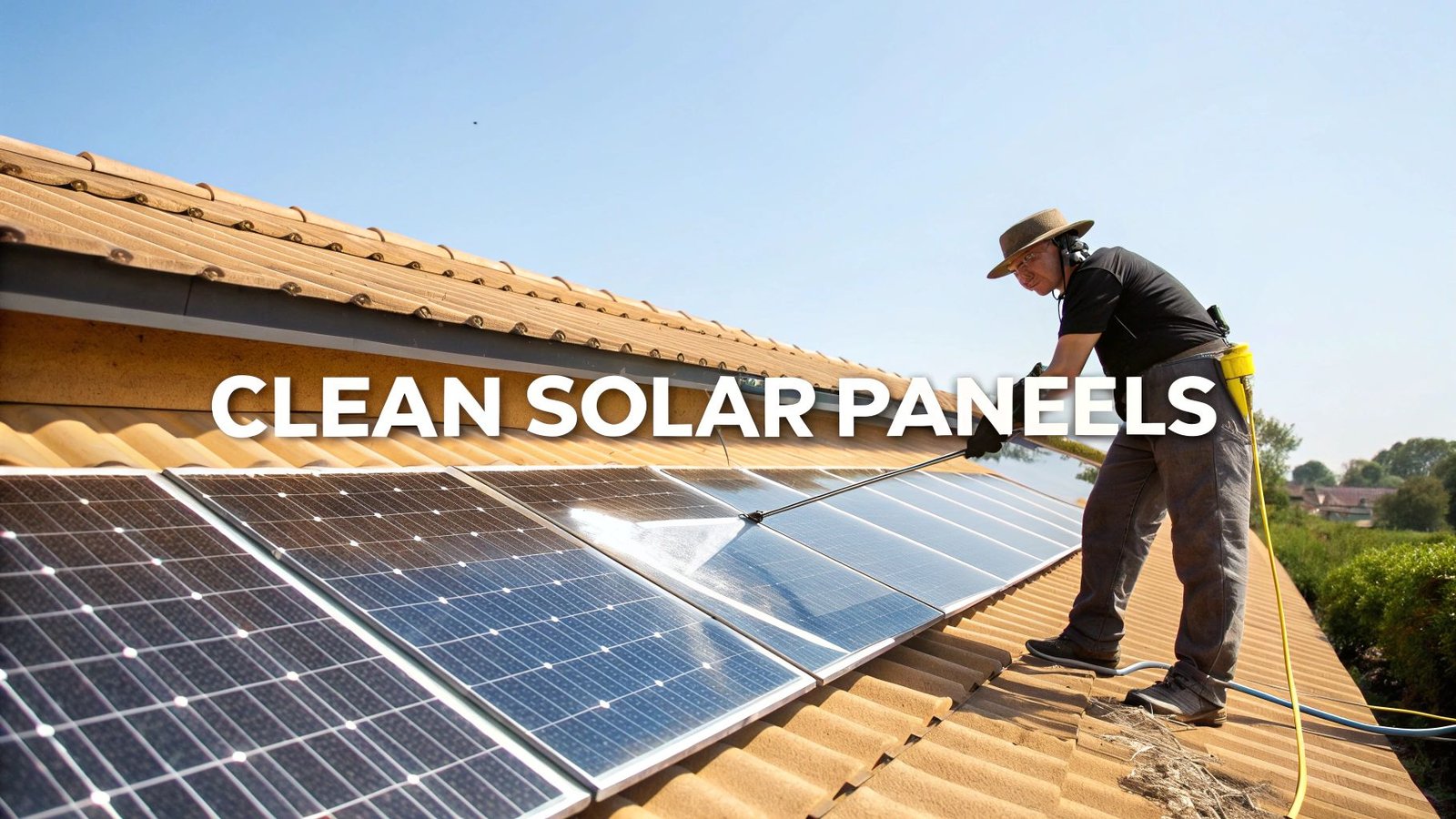When you start looking into solar energy for your home, the pros and cons often boil down to a simple trade-off: you get long-term savings and a smaller carbon footprint, but you have to face a significant upfront cost and accept that you're dependent on the weather. For a lot of homeowners, the combination of financial incentives and much lower electricity bills makes it a smart move, but that initial price tag is still the biggest hurdle.
The Reality of Home Solar Energy
Deciding to go solar is a big deal, both financially and practically. It’s easy to get lost in a simple list of positives and negatives, but the reality has a lot more texture. Before getting into the nitty-gritty, you need to understand the core trade-offs. This isn't just about saving a few bucks; it's about figuring out if the whole solar lifestyle—from installation to day-to-day use—is a good fit for your house, your family, and your budget. If you need a refresher, our guide on what solar energy is and how it works is a great place to start.
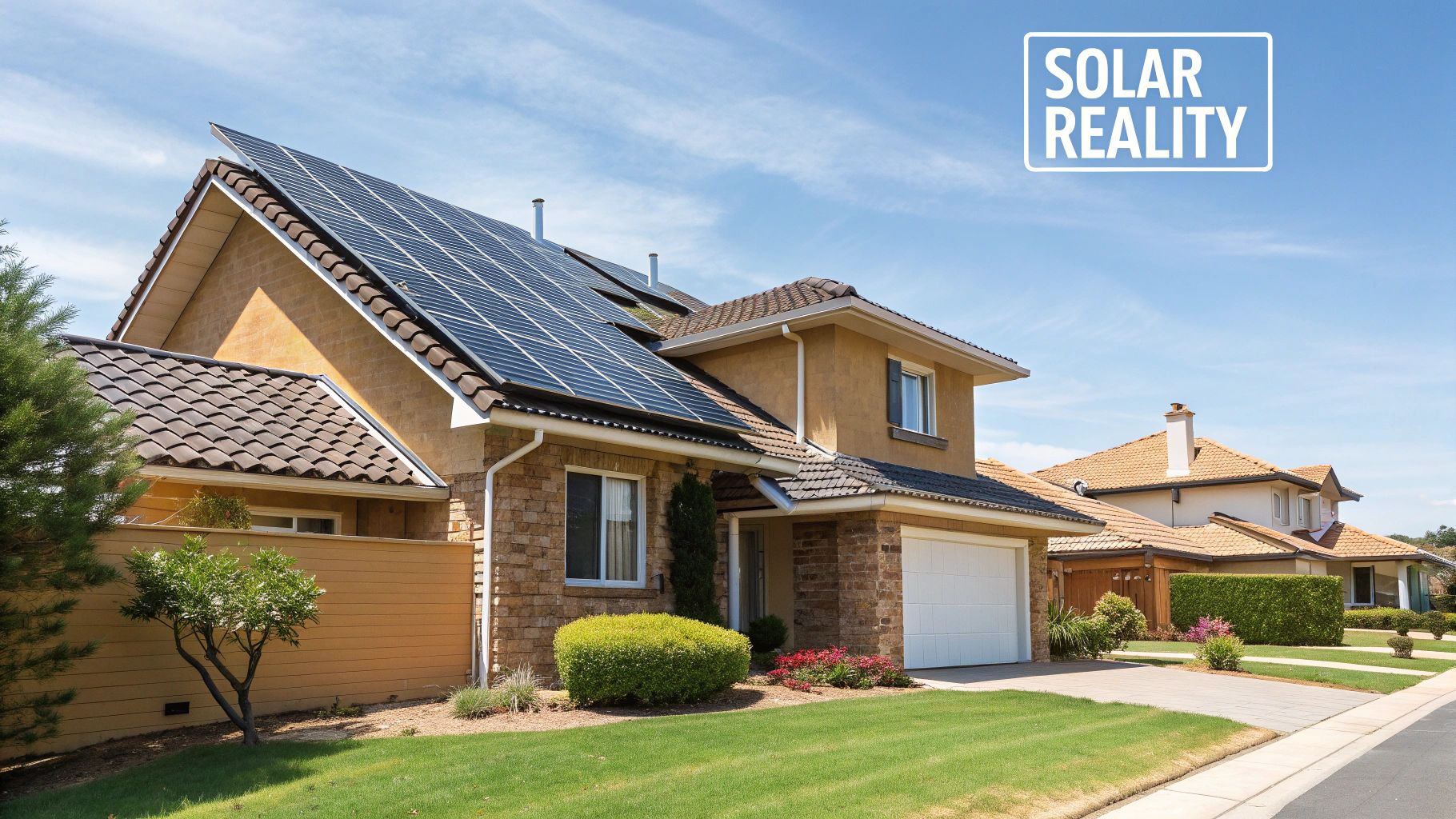
A Balanced Overview
Residential solar has absolutely exploded in popularity. In the U.S. alone, more than 4.7 million homes now have solar panels on their roofs, which says a lot about how costs have dropped and government incentives have kicked in. This boom shows that people are gaining real confidence in solar as a legitimate, long-term power solution.
graph TD
subgraph Solar Adoption Growth in the U.S. (Illustrative)
direction LR
A[2015] --> B(Approx. 900,000 Homes);
B --> C[2020];
C --> D(Approx. 2.8 Million Homes);
D --> E[2024];
E --> F(Over 4.7 Million Homes);
end
style A fill:#f9f,stroke:#333,stroke-width:2px
style C fill:#f9f,stroke:#333,stroke-width:2px
style E fill:#f9f,stroke:#333,stroke-width:2px
But just because it's popular doesn't mean it's right for everyone. The decision really comes down to weighing the tangible benefits against some very real-world challenges.
A successful solar investment is never one-size-fits-all. It all comes down to your specific situation—where you live, the condition of your roof, your local utility's policies, and how much electricity you actually use are the biggest pieces of the puzzle.
To give you a clear, high-level look, I've put together a quick comparison of the fundamental pros and cons. Think of this table as a starting point that sets the stage for the more detailed analysis to come.
At a Glance: Solar Energy Pros vs Cons
| Key Aspect | The Upside (Pro) | The Downside (Con) |
|---|---|---|
| Financials | Drastically lower or even zeroed-out monthly electricity bills, plus a solid long-term return on investment. | A high upfront installation cost and a payback period that can stretch out for several years. |
| Environment | Slashes your household's carbon footprint by tapping into clean, renewable power from the sun. | Manufacturing the panels has its own environmental impact, though it's a fraction of what fossil fuels produce. |
| Reliability | Gives you energy independence from the grid and acts as a shield against unpredictable utility rate hikes. | Power generation is inconsistent—it depends on sunlight and requires battery storage for around-the-clock power. |
| Property | Can genuinely increase your home's value and makes it more appealing to buyers who care about sustainability. | Not all roofs are created equal; you need the right orientation, angle, and structural strength to make it work. |
This table lays out the core give-and-take. As we dig deeper, we'll explore each of these points with real-world examples to help you figure out which side of the equation you fall on.
Breaking Down the Financial Case for Solar
Let's get right to it: most people go solar to save money. While slashing your monthly electric bill is the most immediate and satisfying perk, the full financial picture is much bigger. When you really dig into the pros and cons of solar energy for your home, you start to see it less as a home improvement project and more as a long-term financial strategy.
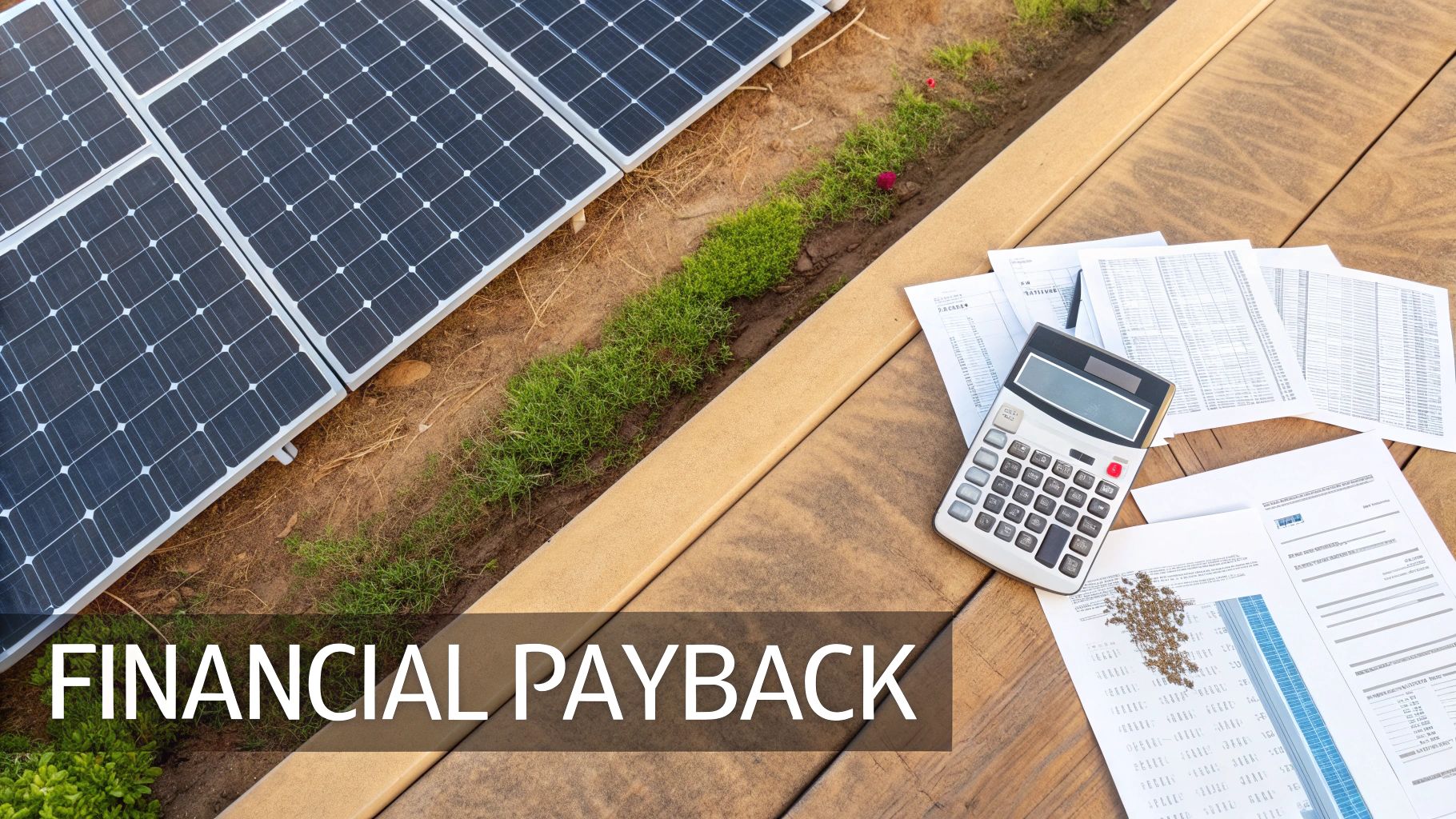
This investment starts working for you from day one by drastically cutting, or even completely eliminating, your dependence on the power company. On average, a typical household can pocket savings of around $1,500 per year. Of course, this number will shift based on your local utility's rates and how much power your family uses. Just as importantly, solar acts as a shield against the endless upward creep of energy prices.
Understanding Your Solar Payback Period
Your "solar payback period" is simply the time it takes for the money you've saved on electricity to match what you initially paid for the system. Think of it as your break-even point. For most homeowners in the U.S., this timeline usually lands somewhere between 10 and 12 years.
Once you cross that threshold, every bit of energy your panels produce is pure profit. It's free power for the rest of the system’s 25+ year lifespan.
gantt
title Solar System Financial Timeline
dateFormat YYYY
axisFormat %Y
section Investment & Payback
Initial Cost :crit, 2025, 1d
Payback Period : 2025, 11y
section Pure Savings
Free Energy :done, 2036, 14y
What makes that timeline shorter or longer? A few key things come into play:
- Initial System Cost: The bottom-line price you pay after any rebates are applied.
- Local Electricity Rates: If you live where electricity is expensive, your savings add up much faster, shrinking your payback period.
- Sunlight Exposure: It’s simple—more sun means more power generation and a quicker return on your investment.
- Available Incentives: This is a big one. Tax credits and local perks can take a huge bite out of the upfront cost.
If you want to see how these numbers shake out for your own home, a solar return on investment calculator is a great tool for getting a personalized estimate.
The real financial power of solar isn’t just about the monthly bill. It’s about converting a recurring expense into a tangible asset that appreciates in value and delivers predictable, long-term returns.
Supercharging Your ROI with Incentives
Government and utility incentives are game-changers. They exist to make solar more affordable and to shorten that payback period we just talked about.
The biggest one by far is the Crédito fiscal solar federal. This allows you to claim 30% of your total system cost as a credit against your federal taxes. To be clear, this is a dollar-for-dollar credit, not just a deduction, meaning it directly reduces the amount of tax you owe. It’s a massive saving.
But it doesn't stop there. Many states and even local utility companies offer their own sweeteners:
- State Rebates: Some states offer cash back right off the bat, lowering your initial out-of-pocket cost.
- Incentivos basados en el rendimiento (PBI): In some markets, programs like Solar Renewable Energy Credits (SRECs) actually pay you for the clean energy you produce. You earn credits that you can then sell.
- Property Tax Exemptions: Even though solar panels add real value to your home, many states have laws preventing your property taxes from going up as a result.
This combination of financial support is a crucial piece of the puzzle when weighing the pros and cons. And to top it all off, studies have consistently shown that homes with solar panels sell for a premium—on average, up to 6.9% more than similar homes without them. It’s not just an energy investment; it’s an investment in your home's equity.
Evaluating the Environmental Impact
Let's look beyond the money-saving aspect for a moment. One of the most powerful reasons homeowners go solar is the undeniable positive impact it has on the environment. When you install a solar system on your roof, you're taking direct action to shrink your household's carbon footprint by generating clean, renewable power instead of pulling it from fossil-fuel-burning plants.
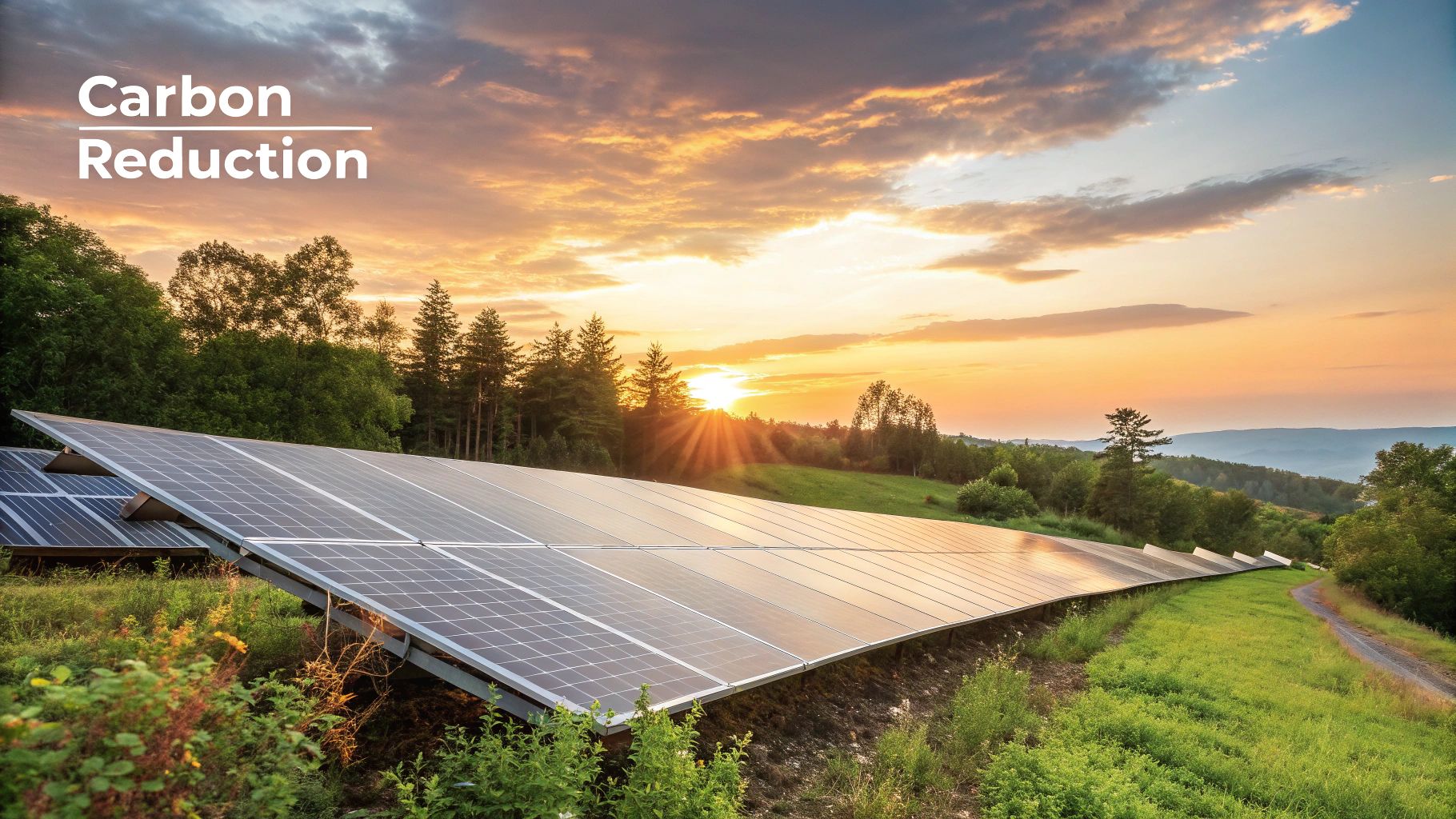
This isn't just a feel-good gesture; the switch has a real, measurable effect. A typical home solar system can cut out about 1.5 tons of carbon dioxide emissions every single year. To put that in perspective, that's like planting over 70 trees annually. By making your own power, you're actively helping to improve the air quality right in your own neighborhood.
Reducing Your Household Carbon Footprint
The logic here is pretty simple. Most of our electricity comes from traditional power plants that burn coal or natural gas, which pumps harmful greenhouse gases like CO2 into the atmosphere. These emissions are a huge part of the climate change puzzle. Solar panels, on the other hand, produce electricity with zero emissions, directly breaking your reliance on those polluting sources.
pie
title U.S. Electricity Generation Sources (Approx.)
"Natural Gas" : 43
"Nuclear" : 19
"Coal" : 16
"Renewables (Wind, Solar, etc.)" : 21
"Other" : 1
Your individual choice is part of a much bigger, global shift. Solar energy is expanding at a breakneck pace as a crucial tool for fighting climate change. In a recent massive push, China accounted for nearly 60% of new global solar installations, proving that solar can meet massive energy demands cleanly. You can dig into the numbers in this snapshot of global PV markets.
This investment in your home ripples outward, supporting a more sustainable world and helping to address the broader challenges of climate change and natural disasters.
When you choose solar, you aren't just powering your house. You're making a conscious decision to move away from fossil fuels and invest in a cleaner, more resilient energy future. Every kilowatt-hour your roof generates is one less that needs to be churned out by a conventional power plant.
Fostering a More Resilient Power Grid
Here's something a lot of people overlook: home solar also helps build a more stable and independent power grid for everyone. Our traditional energy infrastructure is highly centralized. It relies on a handful of massive power plants, which makes the entire system vulnerable. If one of them fails or gets knocked out by extreme weather, it can cause widespread outages.
Residential solar systems are what we call "distributed energy resources," and they create a decentralized network of power generation. This kind of structure makes the grid more resilient by spreading out energy production. It reduces the strain on the central system and makes it so a localized problem doesn't cascade into a regional one.
Your home essentially becomes a mini power station, contributing to a more secure and robust energy supply for your entire community. It’s a subtle but incredibly important benefit, especially as our grid faces increasing instability from climate-related events.
Understanding the Costs and Financial Hurdles
Let's talk about the elephant in the room: the upfront cost. While the long-term financial picture for solar is bright, there's no denying that the initial investment is a major hurdle for many homeowners. This isn't just about buying solar panels; it's about paying for a complete, professionally installed power system for your home.
The final price tag on your solar quote is a package deal. It covers the panels, the inversor (the crucial device that converts DC solar energy into the AC electricity your home uses), the racking and mounting hardware, all the wiring, and the skilled labor to put it all together. On top of that, you have permitting and inspection fees. Getting a clear handle on the full coste de instalación de un sistema de paneles solares is the first, most important step in figuring out if solar is right for your budget.
Breaking Down the Total System Cost
So, where does all that money go? It's easy to assume the panels are the biggest expense, but they’re often just one piece of the puzzle. The cost distribution for a typical residential installation is surprisingly consistent.
Let's look at a realistic breakdown of expenses for a standard solar installation.
Cost Breakdown for a Typical Residential Solar System
This table provides an estimated breakdown of expenses for a standard 6kW residential solar installation, showing the percentage of total cost for each component.
| Component or Service | Estimated Cost Percentage | Key Considerations |
|---|---|---|
| Solar Panels | 25% – 30% | The core of the system. Cost varies by brand, efficiency, and wattage. |
| Inverter | 10% – 15% | A critical component that will likely need replacement in 10-15 years. |
| Labor & Installation | 10% – 15% | Covers the wages for the certified crew installing the system on your roof. |
| Permitting & Inspection | 5% – 10% | Fees required by your local municipality to ensure the system is safe and up to code. |
| Balance of System | 30% – 50% | This includes all the other parts: wiring, racking, mounts, and operational overhead. |
As you can see, the "soft costs"—labor, permits, and other system components—can easily make up half of the total price. This is a critical detail that often gets overlooked.
Exploring Your Financing Options
That initial price tag can feel intimidating, but the good news is that very few homeowners pay for their systems entirely out of pocket. A variety of financing options have put solar within reach for millions.
- Solar Loans: This is the most common path. You borrow the money to purchase the system, so you own it from day one. This allows you to take full advantage of incentives like the federal tax credit.
- Solar Leases: Here, a third-party company owns and maintains the system on your roof. You just pay a fixed monthly fee to use the electricity it produces, which is usually less than what you were paying your utility.
- Power Purchase Agreements (PPAs): A PPA is similar to a lease, but instead of a flat fee, you agree to buy the electricity your system generates at a set rate per kilowatt-hour. The developer installs it at no cost to you, and your rate is often locked in below the utility's price.
Owning your system with a loan almost always delivers the best long-term financial return. You build equity in your home and get to keep 100% of the energy savings once the loan is paid off. Leases and PPAs are great for immediate savings with zero down, but you're essentially renting the equipment and giving the most valuable tax benefits to the provider.
The cost of solar has dropped dramatically over the past decade, making it a more viable investment than ever before. In the United States, solar has become the fastest-growing source of new electricity. In fact, solar and wind are projected to make up a huge share of new power generation, a trend you can discover more insights about on climatecentral.org. This massive growth underscores just how cost-effective solar has become for regular homeowners.
The Not-So-Sunny Side: Practical Limitations and Challenges
Beyond the big-ticket price, it's the day-to-day realities of solar that often catch homeowners by surprise. Solar power is fantastic, but it isn’t magic. You need to go in with a clear understanding of the real-world hurdles before committing.
The biggest one? Intermittency. It's a simple fact: solar panels only make power when the sun is shining. That means production grinds to a halt every single night and takes a nosedive on cloudy, rainy, or snowy days.
xychart-beta
title "Typical Solar Production vs. Home Energy Use"
x-axis [6, 7, 8, 9, 10, 11, 12, 13, 14, 15, 16, 17, 18, 19, 20, 21]
y-axis "Energy (kWh)" 0 --> 5
bar "Home Use" [0.5, 0.8, 1, 0.8, 0.7, 0.6, 0.8, 0.7, 0.8, 1, 1.5, 2.5, 3.5, 4, 3, 2]
line "Solar Production" [0, 0.2, 0.8, 1.5, 2.5, 3.5, 4, 4.5, 4.2, 3.5, 2.5, 1, 0.2, 0, 0, 0]
This creates a fundamental disconnect. Your panels are working overtime in the middle of the day, but your family's peak energy usage is often in the evening. Without a battery to store that midday power, you’re right back to buying electricity from the utility company as soon as the sun goes down.
Is Your Home Even a Good Candidate?
Your property's unique characteristics will make or break your solar investment. A poorly sited system is a recipe for disappointment, so it's critical to know if your home is cut out for solar in the first place.
Here’s what the pros look at:
- Roof Direction and Tilt: For homes in the U.S., a south-facing roof is the ideal. It gets the most direct sunlight throughout the day. East or west-facing roofs can work, but you'll have to accept that your system won't produce as much power.
- How Much Space You Have: You need a good chunk of clear, usable roof space to fit enough panels to cover your electricity needs. A small or chopped-up roof can be a major roadblock.
- The Shade Factor: This is a huge deal. Persistent shade from trees, chimneys, or a neighbor's house can tank your system's output. Even a little shadow on a single panel can sometimes reduce the performance of the entire connected group.
This is why a professional site assessment isn't just a suggestion—it's absolutely essential. It tells you whether solar is a smart move for your specific property.
A solar panel system’s success isn't just about the hardware. It's dictated by the fixed realities of your geography, local regulations, and even your HOA's rulebook.
Untangling the Red Tape: Policies and Permits
Honestly, dealing with the paperwork and local rules can be one of the most frustrating parts of the whole process. The policies aren't just different from state to state; they can change from one town to the next.
For instance, Homeowners' Associations (HOAs) are notorious for having strict aesthetic guidelines that can limit where—or even if—you can install panels. On top of that, the local permitting process can be a slow, bureaucratic headache that adds unexpected delays and costs.
The most critical policy to understand is net metering. This is how your utility company credits you for the extra solar energy you send to the grid. A good net metering program can dramatically speed up your return on investment. A bad one, however, can seriously weaken the financial argument for going solar. Digging into your local utility's policy is non-negotiable.
Making an Informed Decision for Your Home
Deciding whether to go solar isn't a one-size-fits-all process. The right choice really comes down to your specific home, your financial situation, and what you're hoping to achieve. For instance, if you're a long-term investor, your focus might be purely on the return, which is a totally different game than if you're primarily motivated by shrinking your carbon footprint.
To figure this out with confidence, you have to look at a few key things. Start with your average monthly electricity bill—this is the baseline that will determine how big of a system you actually need. After that, the condition of your roof, its age, and which way it faces are all critical pieces of the puzzle that dictate whether a solar installation is even feasible.
Your Personal Solar Checklist
Before you start getting quotes, it's worth taking a moment to see how your home stacks up against the practical realities of a solar panel system. A little self-assessment now can save you a lot of time and potential frustration down the road.
This decision tree gives you a clear visual of the main hurdles you might encounter, from getting enough sun to dealing with local rules.
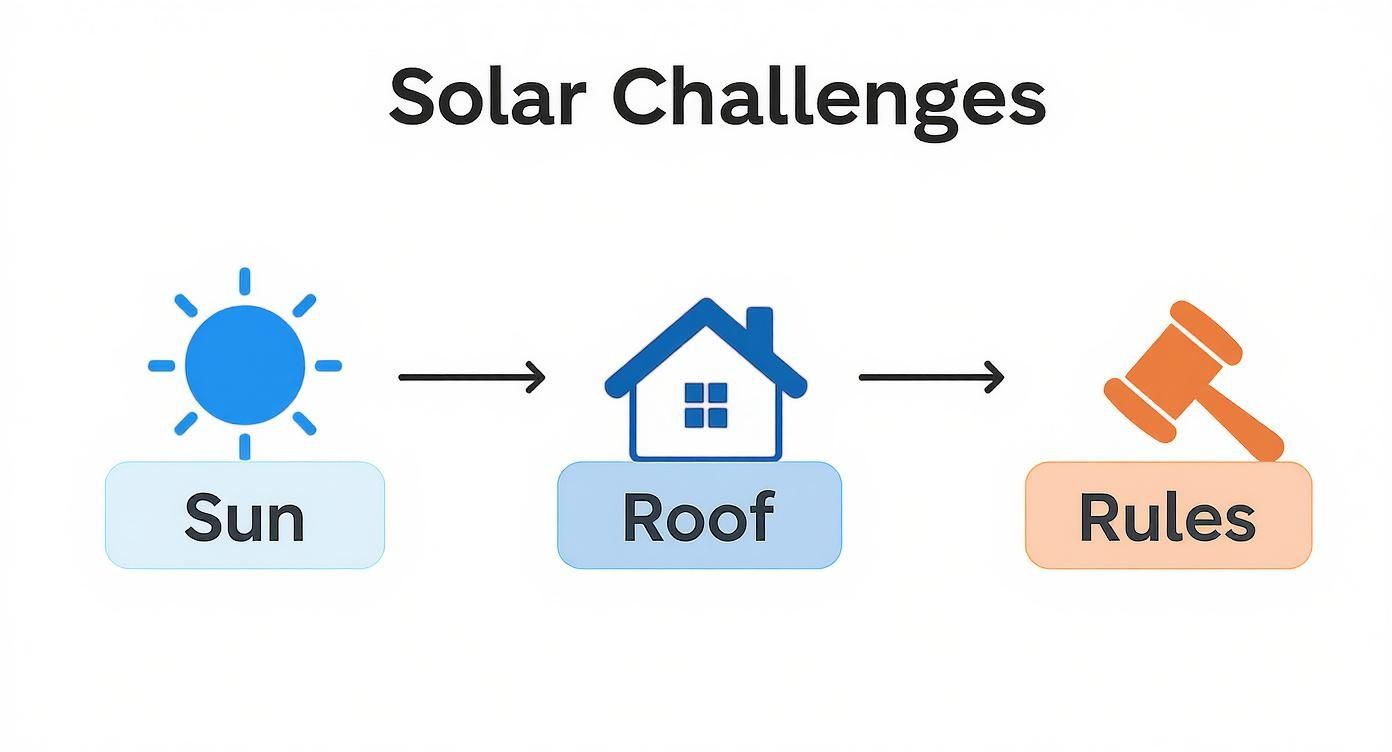
As you can see, a successful project means clearing a series of checkpoints, starting with the environment around you and moving through your home's structure and even local regulations.
Beyond your roof, think about your regional climate and—this is a big one—the financial incentives available where you live. State and federal credits can dramatically shorten your payback period and boost your overall savings.
The best decision comes from synthesizing data with your priorities. Match your high electricity bills with a suitable roof, strong local incentives, and a long-term view to build a powerful case for switching to solar.
At the end of the day, the goal is to make sure the practical side of solar lines up with what you want to accomplish. If your house checks all the right boxes and you're comfortable with the upfront investment, solar energy can be an incredibly smart and rewarding upgrade for your property.
Your Top Home Solar Questions, Answered
Thinking about going solar always brings up a few key questions. It's a big decision, after all. Let's tackle some of the most common ones that homeowners ask when they're weighing their options.
How Long Do Solar Panels Last?
Modern solar panels are built like tanks. You can expect them to come with a performance warranty that guarantees they'll work for De 25 a 30 años. And honestly, they often keep chugging along well past that date, just with a slight dip in efficiency over time.
The first part of your system you'll likely need to replace is the inverter—the box that converts the sun's energy into power your house can use. Those typically have a lifespan of about De 10 a 15 años.
What Happens During a Power Outage?
This is a big one that surprises a lot of people. For safety, a standard grid-tied solar system automatically shuts down when the power goes out. This is a crucial feature that protects utility workers from getting shocked while they're repairing the lines.
If you want to keep the lights on during an outage, you'll need to pair your solar panels with a battery storage system. The battery saves up your excess solar power, creating your own personal energy reserve you can tap into when the grid goes down.
Do I Need a Perfect South-Facing Roof?
While a south-facing roof is the gold standard for maximizing sunlight in the Northern Hemisphere, it's definitely not a deal-breaker. Don't count yourself out if your roof doesn't face due south.
East- and west-facing roofs are also great candidates for solar. A skilled installer can design a system that works perfectly for your home's unique layout, taking into account your roof's orientation and even timing energy production to match when your family uses the most electricity.
Ready to see if solar is the right fit for your home? The experts at Energía radiante can provide a personalized assessment and a free quote to help you understand your potential savings and system options. Learn more about our solar solutions.

